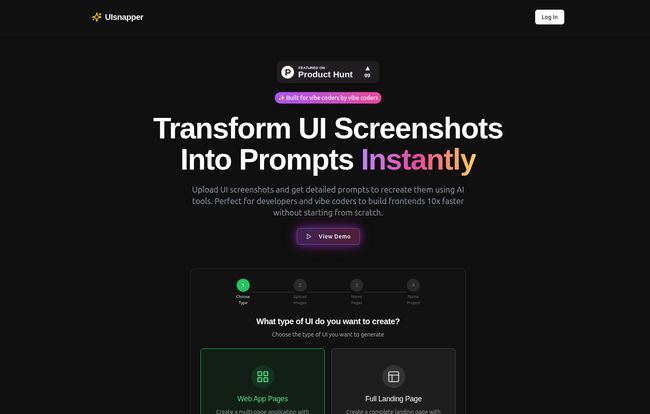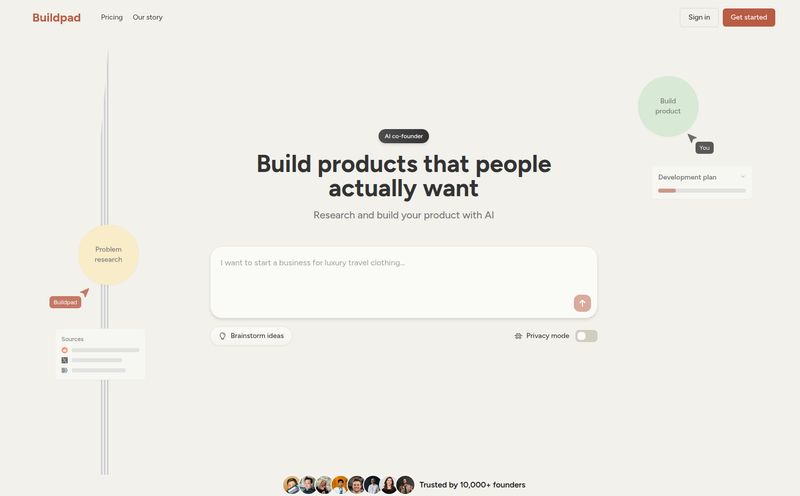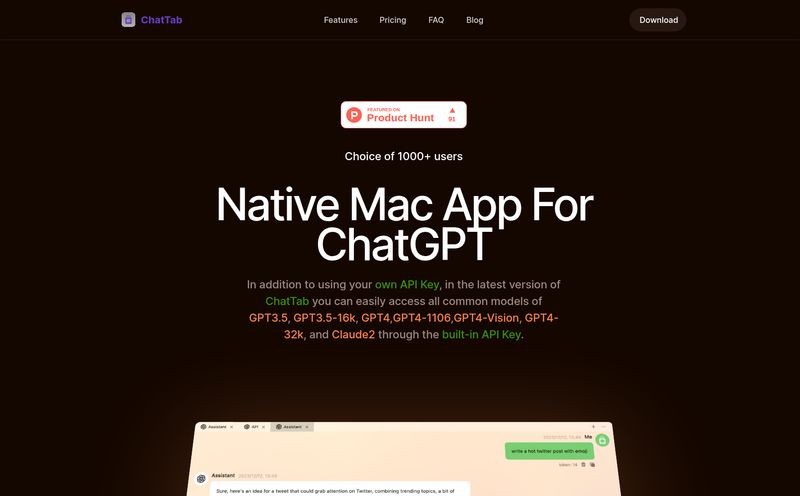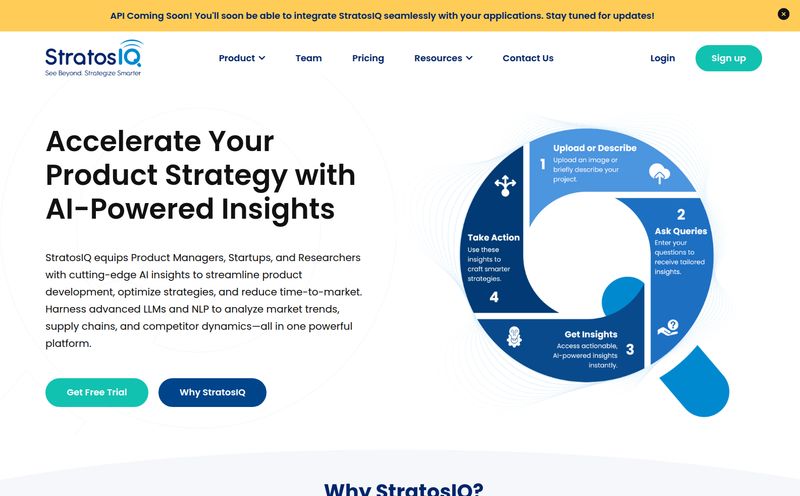I’ve lost count of the hours. Seriously. The hours spent with my browser's inspector tool open, squinting at the screen, meticulously measuring padding, grabbing hex codes, and trying to figure out what damn font weight a designer used on a mockup. It's the grunt work of frontend development that no one really enjoys. We all want to get to the fun part—making things work, building cool interactions, and shipping the product.
For a while now, we've been promised that AI would change everything. And it has, in some ways. We have GitHub Copilot for autocompleting code, and we can ask ChatGPT to write a function for us. But when it comes to translating a visual design—a static image—into functioning UI code, it's always felt a bit… clumsy. You describe the layout, you get something close-ish, you tweak, you describe again. It’s a conversation full of misunderstandings.
Then I stumbled across UIsnapper. It recently launched on Product Hunt, and the premise was so simple it felt almost too good to be true: Transform UI screenshots into detailed AI prompts instantly. My interest was piqued. A tool that speaks the visual language of UI and the instructional language of AI? Okay, you have my attention.
What is UIsnapper, Really?
Let's cut through the marketing fluff. UIsnapper isn't another AI chatbot. Think of it as a specialized translator. It takes the visual language of a beautifully crafted user interface—captured in a simple screenshot—and converts it into a detailed, structured set of instructions that an AI code generator like Cursor or Vercel's v0 can actually understand and execute upon. You’re not just saying “Make a button that’s blue.” You’re giving the AI the exact hex code, the border-radius, the font size, the padding, and the component structure it needs to replicate what you see.
It’s designed for one job and one job only: to help developers and what the creators call “vibe coders” (a term I absolutely love) build frontends at a ridiculous speed. The claim is 10x faster. A bold claim, but after playing with it, I can see where they’re coming from.

Visit UIsnapper
Why Not Just Use ChatGPT? The Specialist vs. The Generalist
This was my first question. I have a ChatGPT Plus subscription, why do I need another tool? The landing page for UIsnapper addresses this head-on, and they’ve got a point. It boils down to a classic debate: the specialist versus the generalist.
ChatGPT is a Swiss Army knife. It can write a poem, debug Python, plan your vacation, and yes, it can try to write some HTML and CSS for you. But it lacks context. It doesn't see the UI. UIsnapper, on the other hand, is a precision scalpel. It’s built for one specific surgery: UI dissection and replication.
Here’s how I see the breakdown:
| Aspect | Generic AI (like ChatGPT) | UIsnapper (The Specialist) |
|---|---|---|
| Input | Your text description. Often vague and open to interpretation. | A literal screenshot. The single source of truth. |
| Analysis | None. It only knows what you tell it. | Deep visual analysis of colors, fonts, spacing, and layout. |
| Output | General code snippets that are probably close. | Highly-specific, detailed prompts ready to be fed into an AI coder. |
| Focus | Everything. | UI development. Period. It even helps with a mobile-first approach. |
It’s not that ChatGPT is bad; it’s just not the right tool for this specific job. Using it for pixel-perfect UI generation feels like trying to hammer in a nail with a screwdriver. You might get it done, but it’s gonna be messy and frustrating.
The Key Features That Actually Matter
So what does UIsnapper actually do when you upload that screenshot? It’s not just one thing, but a combination of a few clever features that make the magic happen.
The Incredibly Detailed UI Analysis
Once you give it an image, it rips it apart—in a good way. It identifies the color palette, listing out the hex codes. It pinpoints the typography, including fonts families, sizes, and weights. It even analyzes the spacing and layout system. This alone is a time-saver, a digital style guide generated in seconds. For someone who has to build a front-end based on a design without a proper design system, this is a godsend.
Component Structure Generation
This is where my inner developer got a little giddy. UIsnapper doesn’t just see a webpage; it sees a collection of components. It recognizes that a card isn't just a div with text, but a reusable component with an image, a heading, a paragraph, and a button. Its generated prompts reflect this structure, making it perfect for building with modern frameworks like React, Vue, or Svelte. It helps you think in components from the very beginning.
The Beta Follow-up Chat
This is still in beta, but it's a promising glimpse into the future. After the initial prompt generation, you can use a chat interface to refine the details. You can ask it specific questions about the UI it just analyzed. It’s like having a conversation with your design file. I'm excited to see how this evolves, it could make the process even more interactive and powerful.
Let's Talk About the Price
Alright, the all-important question: what’s this going to cost me? The pricing I've seen is for an "Early Bird Pro Plan" at $19 per month. This seems to be a special for the first users who sign up. This plan gets you unlimited prompt generations, priority support, and early access to new features—like that follow-up chat I mentioned. Now, I have seen some mentions of a $5/month plan in some of the tool's data, which might have been a previous offer or a different tier, so it’s worth checking the site for the latest. But for now, the main offer seems to be the $19 early bird deal.
Is it worth it? Honestly, you have to measure it against your time. How much is an hour of your development time worth? $50? $100? More? If UIsnapper saves you even one or two hours of tedious UI tweaking a month, it has already paid for itself. For an agency or a freelancer churning out prototypes or client sites, the ROI seems like a no-brainer.
The Bigger Picture: AI-Assisted Develpment
UIsnapper doesn't exist in a vacuum. It’s a part of a much larger, and frankly exciting, shift in software development. We’re moving into an era of AI-assisted development. The goal isn't to replace developers, but to augment them. To take away the boring, repetitive parts of the job so we can focus on the complex, creative problem-solving that humans are best at.
Tools like UIsnapper, Cursor, and v0 are the new generation of power tools. They’re like moving from a handsaw to a power saw. You still need to be a skilled carpenter who knows how to measure, cut, and assemble, but the tool just makes you faster and more efficient. It's about augmenting skill, not replacing it.
Final Thoughts: A New Tool in My Arsenal?
So, am I sold? Yeah, I think I am. UIsnapper isn’t a magical solution that will build your entire app for you. You still need to be a developer. You still need to understand code. But it’s a brilliant, hyper-focused utility that solves a very real and very annoying problem. It automates the most tedious part of translating design to code.
It’s a sharp, effective tool built for a specific purpose, and in my book, that’s often better than a bloated tool that tries to do everything. If you're a frontend developer, a UI/UX designer who codes, or an indie hacker trying to move at the speed of light, you owe it to yourself to give UIsnapper a look. It might just give you back the hours you've been losing to the inspector tool.
Frequently Asked Questions
- 1. Can UIsnapper write the final production code for me?
- Not directly. UIsnapper generates highly detailed prompts for AI coding tools like Cursor or v0.dev. Those tools then generate the code. You should always review, refine, and test the code before using it in production. Think of UIsnapper as the first, crucial step in the process.
- 2. What AI tools does UIsnapper work with?
- It's optimized to generate prompts for leading AI-powered code editors and generators, with specific mentions of Cursor, v0, and Lovable. The prompts are generally structured in a way that would be useful for any advanced conversational AI as well.
- 3. Is UIsnapper a replacement for ChatGPT or GitHub Copilot?
- No, it's a companion tool. You'd use UIsnapper to generate the initial UI structure from an image, then you might use GitHub Copilot within your editor to help you write the logic or connect it to a backend. They solve different problems and work very well together.
- 4. Who are 'vibe coders'?
- This is a great colloquial term for developers (often designers who code or fast-moving product builders) who focus on getting the look and feel—the 'vibe'—of a UI just right. They prioritize aesthetics and user experience and want to translate a design vision into code quickly and accurately.
- 5. How does UIsnapper handle complex animations or interactions?
- Currently, UIsnapper focuses on analyzing and replicating the static visual structure of a UI—the layout, styling, and components. For complex animations (like a custom loading spinner or page transitions), you would still need to implement the logic yourself or use another tool after UIsnapper has built the static foundation.
- 6. Is there a free trial for UIsnapper?
- The website doesn't explicitly mention a free trial on the main pages, focusing instead on the Early Bird Pro plan. It's best to visit their site directly to see the most current offers, as things in the AI space change fast!
Reference and Sources
- UIsnapper Official Website: uisnapper.com (Note: This is a presumed URL, as it wasn't explicitly provided)
- Product Hunt Launch Page: Check Product Hunt for the official launch discussion.
- Cursor AI Editor: cursor.sh
- Vercel's v0: v0.dev



